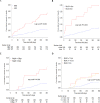Anthropometry at birth and at age of routine vaccination to predict mortality in the first year of life: A birth cohort study in BukinaFaso
- PMID: 30921335
- PMCID: PMC6438502
- DOI: 10.1371/journal.pone.0213523
Anthropometry at birth and at age of routine vaccination to predict mortality in the first year of life: A birth cohort study in BukinaFaso
Abstract
Background: The World Health Organization currently defines severe acute malnutrition (SAM) in infants aged under 6 months of age using weight-for-length Z score (WLZ). Given widespread use of mid-upper arm circumference (MUAC) for identifying SAM in older children and weight-for-age (WAZ) for growth monitoring, there is increasing debate about the optimal anthropometric criteria to best identify infants u6m at-risk of mortality.
Objective: To determine the discriminatory value for mortality during the first 12 months of life of anthropometry taken at birth and at age two months (approximate age of routine vaccination).
Design: Data were analyzed from a birth cohort recruited between April and December of 2004 at four health facilities within Bansalogho District in Burkina Faso. Infants were followed up for 12 months. Mortality risks were estimated using hazards ratios (HR). Discriminatory value was assessed using receiver operating characteristic curves.
Results: Of 1,103 infants, 227 (21%) were low birthweight (LBW). During 12 months, 86 (7.8%) infants died; 38 (44%) among the LBW group. At birth, MUAC<9.0cm, weight<2.5kg, length<44.2cm and incalculable WLZ were associated with mortality. Sixty (70%) deaths occurred after the age of two months; 26 (43%) among LBW infants. At age two months, any MUAC <11.5cm, weight <3.8kg (WAZ<-3) and length <52.4cm (LAZ<-3) were associated with risk of mortality. WLZ was not associated with mortality at any threshold. Birth weight did not modify the effect of the association between month two MUAC and one-year mortality (P = 0.33).
Conclusion: Infants at heightened risk of mortality and are better identified during early infancy by MUAC or WFA than by WLZ. LBW infants with low anthropometry at the age of routine immunizations remain at elevated risk than normal birth weight (NBW)infants and require intervention. Effectiveness, cost-effectiveness and coverage of applying proposed thresholds should be investigated as a priority to inform policy and practice.
Conflict of interest statement
The authors have declared that no competing interests exist.
Figures


Similar articles
-
Diagnostic criteria for severe acute malnutrition among infants aged under 6 mo.Am J Clin Nutr. 2017 Jun;105(6):1415-1423. doi: 10.3945/ajcn.116.149815. Epub 2017 Apr 19. Am J Clin Nutr. 2017. PMID: 28424189 Free PMC article.
-
Neonatal anthropometric indicators of infant growth and mortality in Burkina Faso.Public Health Nutr. 2024 Apr 19;27(1):e123. doi: 10.1017/S1368980024000880. Public Health Nutr. 2024. PMID: 38639113 Free PMC article. Clinical Trial.
-
Newborn Mid-Upper Arm Circumference Identifies Low-Birth Weight and Vulnerable Infants: A Secondary Analysis.Curr Dev Nutr. 2022 Sep 12;6(10):nzac138. doi: 10.1093/cdn/nzac138. eCollection 2022 Oct. Curr Dev Nutr. 2022. PMID: 36475019 Free PMC article.
-
Feasibility and diagnostic accuracy of neonatal anthropometric measurements in identifying low birthweight and preterm infants in Africa: a systematic review and meta-analysis.BMJ Paediatr Open. 2024 Oct 1;8(1):e002741. doi: 10.1136/bmjpo-2024-002741. BMJ Paediatr Open. 2024. PMID: 39353710 Free PMC article.
-
Severely malnourished children with a low weight-for-height have similar mortality to those with a low mid-upper-arm-circumference: II. Systematic literature review and meta-analysis.Nutr J. 2018 Sep 15;17(1):80. doi: 10.1186/s12937-018-0383-5. Nutr J. 2018. PMID: 30217196 Free PMC article.
Cited by
-
Effectiveness of Postnatal Maternal or Caregiver Interventions on Outcomes among Infants under Six Months with Growth Faltering: A Systematic Review.Nutrients. 2024 Mar 14;16(6):837. doi: 10.3390/nu16060837. Nutrients. 2024. PMID: 38542748 Free PMC article.
-
Antimicrobial and micronutrient interventions for the management of infants under 6 months of age identified with severe malnutrition: a literature review.PeerJ. 2020 Sep 10;8:e9175. doi: 10.7717/peerj.9175. eCollection 2020. PeerJ. 2020. PMID: 32974089 Free PMC article.
-
Carers' and health workers' perspectives on malnutrition in infants aged under six months in rural Ethiopia: A qualitative study.PLoS One. 2022 Jul 21;17(7):e0271733. doi: 10.1371/journal.pone.0271733. eCollection 2022. PLoS One. 2022. PMID: 35862411 Free PMC article.
-
Pathways between caregiver body mass index, the home environment, child nutritional status, and development in children with severe acute malnutrition in Malawi.PLoS One. 2021 Aug 23;16(8):e0255967. doi: 10.1371/journal.pone.0255967. eCollection 2021. PLoS One. 2021. PMID: 34424919 Free PMC article. Clinical Trial.
-
Individualized breastfeeding support for acutely ill, malnourished infants under 6 months old.Matern Child Nutr. 2020 Jan;16(1):e12868. doi: 10.1111/mcn.12868. Epub 2019 Aug 2. Matern Child Nutr. 2020. PMID: 31264337 Free PMC article.
References
-
- Kerac M, Blencowe H, Grijalva-Eternod C, McGrath M, Shoham J, Cole TJ, et al. Prevalence of wasting among under 6-month-old infants in developing countries and implications of new case definitions using WHO growth standards: a secondary data analysis. Arch Dis Child. 2011. Epub 2011/02/04. 10.1136/adc.2010.191882 . - DOI - PMC - PubMed
Publication types
MeSH terms
Grants and funding
LinkOut - more resources
Full Text Sources
Medical
Miscellaneous

